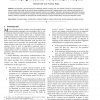613 search results - page 61 / 123 » An analysis framework for network-code programs |
SQJ
2002
14 years 11 months ago
2002
Abstract. The work of Voas and colleagues has introduced, refined and applied the propagation, infection and execution (PIE) analysis technique for measuring testability of program...
CORR
2010
Springer
14 years 12 months ago
2010
Springer
Abstract. Developers express the meaning of the domain ideas in specifically selected identifiers and comments that form the target implemented code. Software maintenance requires ...
111
click to vote
WCRE
2002
IEEE
15 years 4 months ago
2002
IEEE
The University of Queensland Binary Translator (UQBT ) is a static binary translation framework that allows for the translation of binary, executable programs, from one architectu...
IFIP
2007
Springer
15 years 6 months ago
2007
Springer
Capability acquisition graphs (CAGs) provide a powerful framework for modeling insider threats, network attacks and system vulnerabilities. However, CAG-based security modeling sys...
100
click to vote
ICSM
1997
IEEE
15 years 4 months ago
1997
IEEE
ÐWe describe a general technique for identifying modules in legacy code. The method is based on concept analysisÐa branch of lattice theory that can be used to identify similarit...

